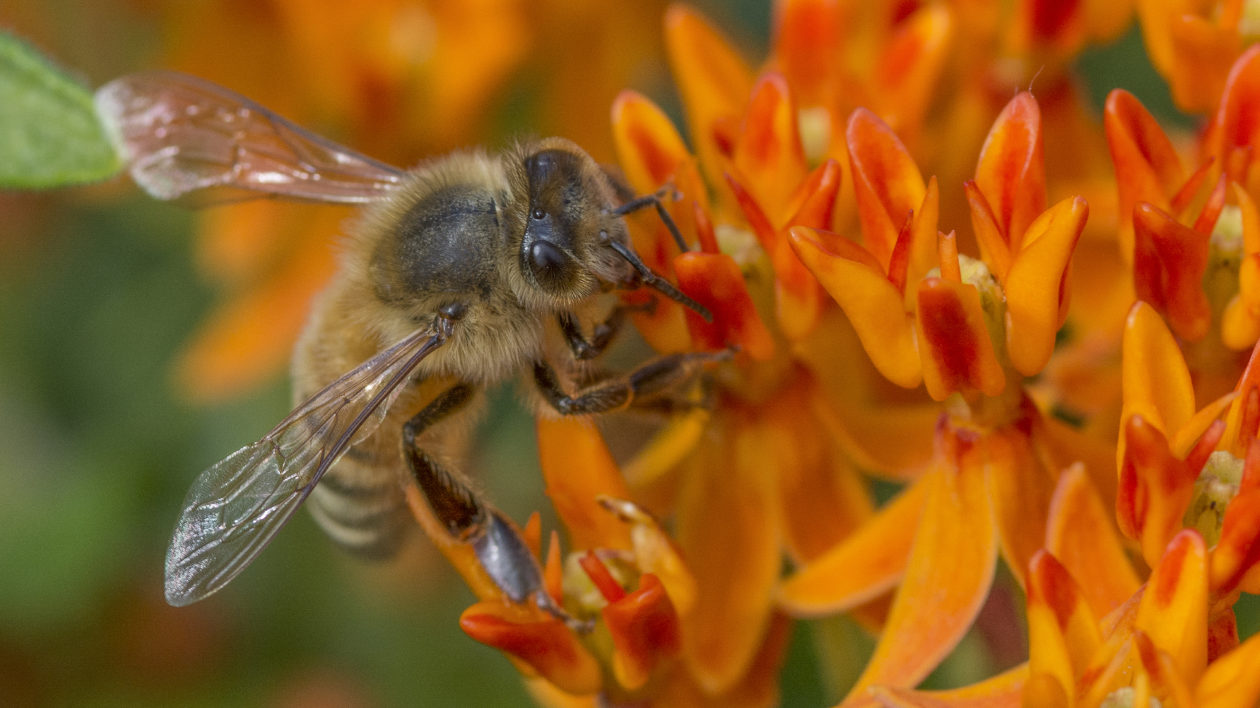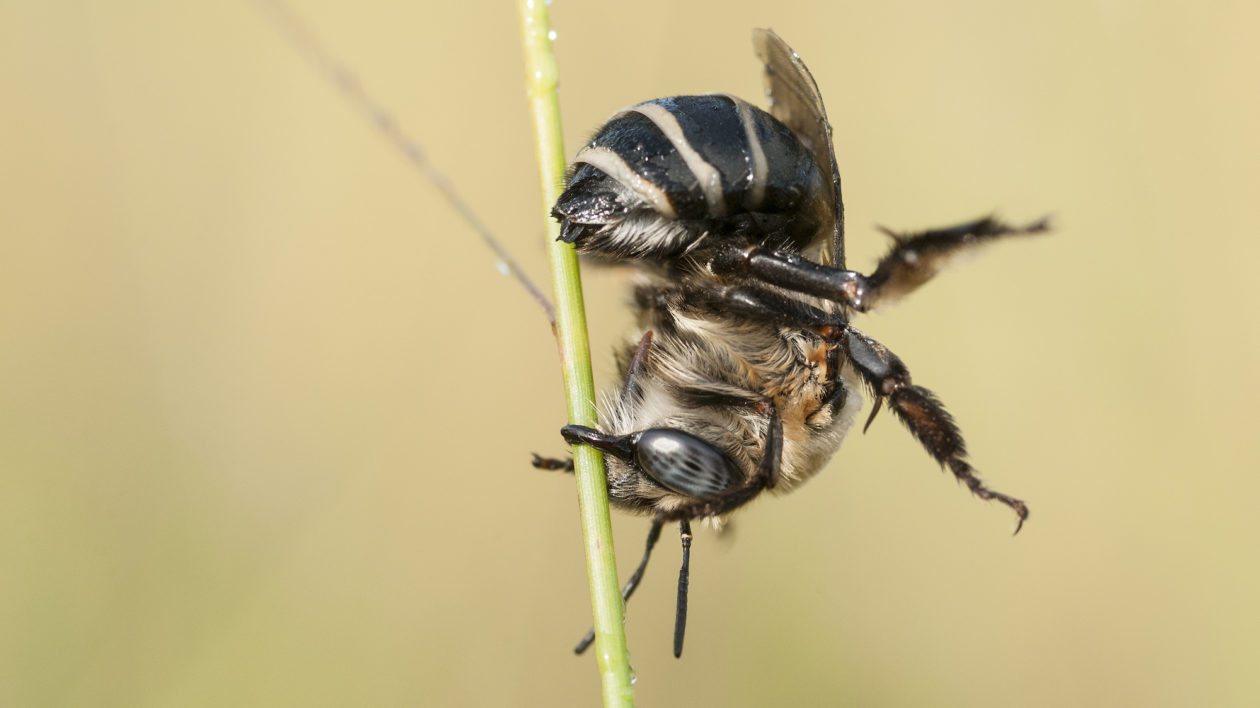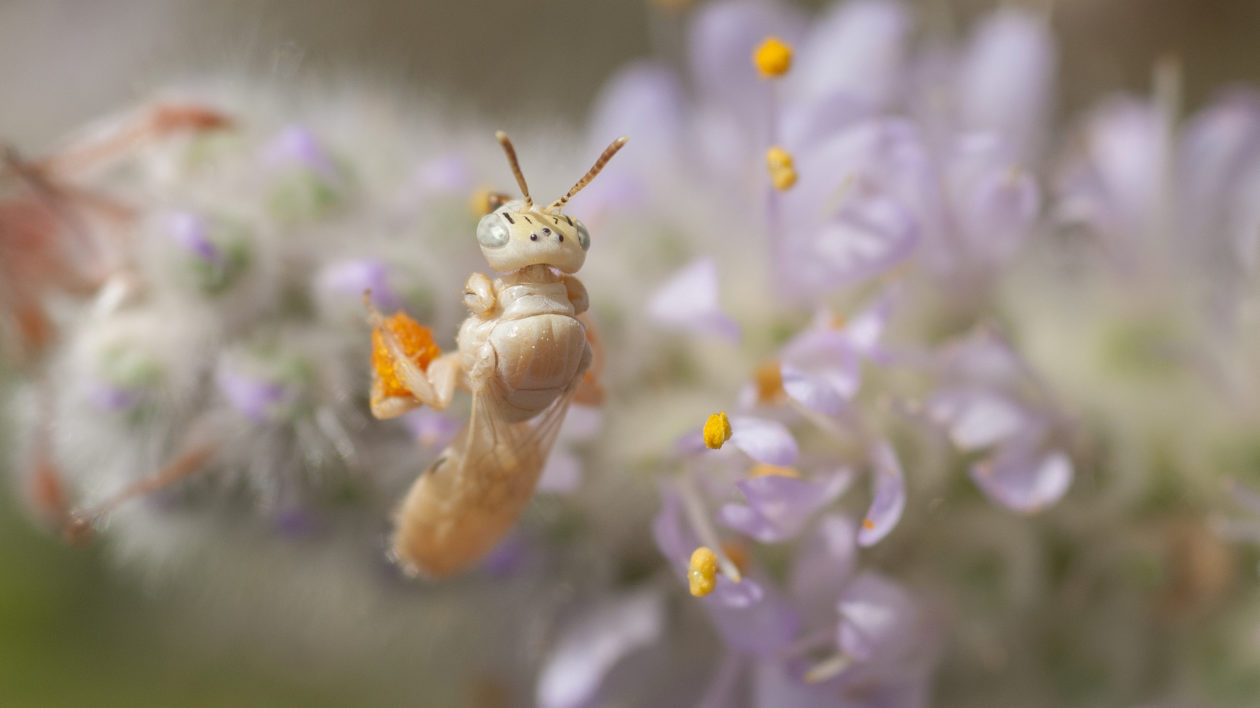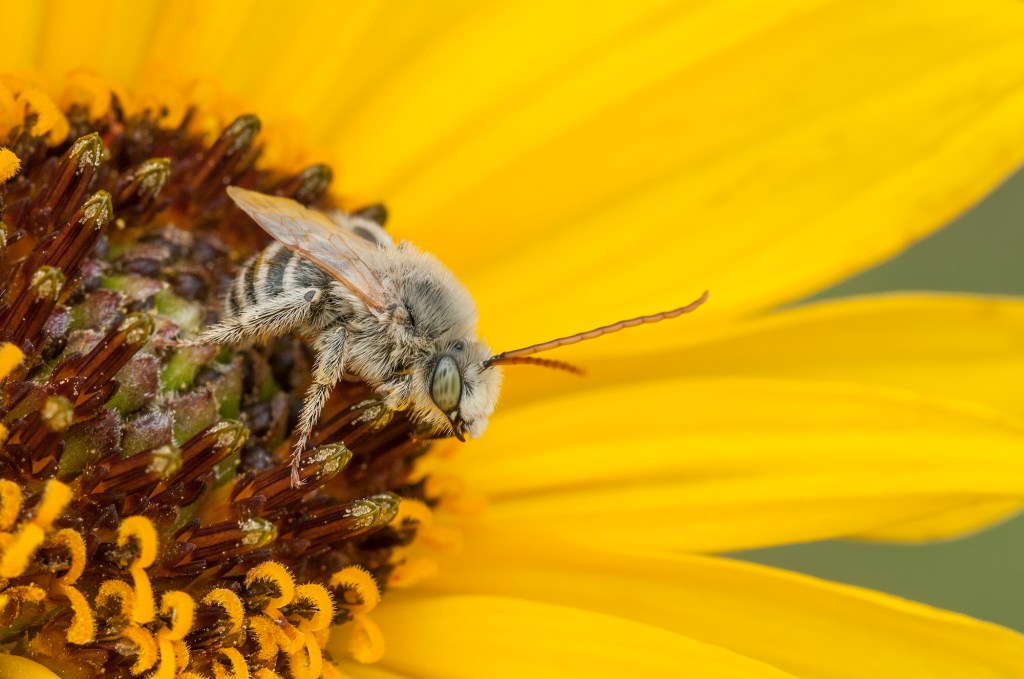The public is very aware that we are in the midst of a pollination crisis. In fact, concern about bees and other pollinators is nearly unanimous in public polling.
At a time when we are polarized on most issues, the need to do something about bees is something we can all agree on. Unfortunately, when people fret about bees and the threats they face, most are thinking about strictly about honey bees.
Honey bees are fascinating creatures. They’ve got an incredible social structure within their hives, they play important roles in the pollination of many food plants we like, and honey is delicious. However, honey bees are also an introduced livestock species in North America and only one of about 4,000 kinds of bees found in North America.
The thousands of native bee species living mostly below our collective radar are split into categories such as digger bees, carpenter bees, mason bees, sweat bees, bumble bees, and cuckoo bees.
The majority of those species don’t live in hives where workers cater to the needs of the queen and raise her babies for her. Instead, most native bees are reared in small nests built and tended by single mothers. Those female bees lay eggs, supply them with food, and protect them from enemies – all by themselves. A distinct minority of native bees live under some kind of cooperative system, and only a very few employ the kind of eusocial behavior we associate with honey bees.

The Dizzying Variety of Native Bees
Native bees also come in a dizzying array of colors, shapes, and feeding preferences. Bumble bees can be as large as your thumb, but many bee species are smaller than a grain of rice. Some are generalists that can feed opportunistically on whichever flowers are most abundant at the time.
Others are much more restricted in their diet, sometimes to a single species or group of species of wildflower. Plants, in turn, display a broad diversity of flower designs that can either make their nectar and pollen available to all comers or limited to only bees of a certain size, tongue length, or ability to vibrate flowers at a specific frequency.
Despite the astonishing variety among bees in North America, most conversations about bee conservation center on a single, largely agricultural species. Imagine if we did the same thing with birds — we’d be trying to raise more turkeys on farms out of concern for massive declines in overall bird populations.

To be clear, honey bees really are suffering declines. In fact, a recent report showed that around 38 percent of managed honey bee colonies in the U.S. were lost during the winter of 2018-19.
Honey bees are in no real danger of extinction, however, because humans are managing their populations. Native bees don’t have that kind of support system.
Honey bees also don’t cover the wide range of ecological roles played by our diverse native bee communities. The aforementioned variety of features and behaviors found within native bees means they can meet the needs of an incredible diversity of flowering plants. In contrast, honey bees provide pollination for a relatively small percentage of native flower species (estimates from around the world vary between 25 percent and 40 percent). In order to conserve the full species diversity and resilience of our ecosystems, we need our native bees.

The Fate of Native Bees
In addition to their inability to shoulder the entire load of pollination, there is also growing evidence that honey bees compete with and potentially contribute to the declines of native bees. That’s concerning, and it should make us thoughtful about how and where we place honey bee hives in and around natural areas. However, it’s also important to know that honey bees are not the primary reason our native bees are suffering.
In fact, honey bees and native bees share most of the same threats to their survival, with the loss of quality habitat topping that list. Similarly, many of the strategies to help save native bees will also help honey bees — and vice versa. We just need to be careful that saving honey bees aren’t the primary focus of conservation efforts or communications.
Increasing the size and quality of habitat for pollinators will boost populations of all bees, including both native bees and honey bees. Yes, certain pesticides and diseases are also causing major problems and we should continue to work on those issues as well.

However, adequate habitat quantity and quality greatly dampens the impacts of those other threats. We need to protect and restore plant diversity in natural areas and agricultural landscapes so that nectar and pollen resources are abundantly available throughout the year. In addition, we need to rebuild and reconnect floristically rich habitats wherever we can. Those are the only viable strategies to conserve bees of all kinds (and most of our native biodiversity).
Compared to those gargantuan tasks, changing the way we talk about bees seems pretty easy, but it is still really important. There are too many news stories that start with something like, “bees are suffering” and then proceed to talk only about honey bees.
Schools talk a lot about the social structure of honey bees, but don’t mention the majority of bees that don’t live that way. As a result, much of the public recognizes that we are experiencing a pollination catastrophe but thinks it’s an issue of bee keepers and their struggles to save their animals.
The real story of pollinators and their declines is much more compelling than the battle to save a livestock industry. The incredible variety among native bees, alone, can catch the public’s attention, especially when accompanied by photos showing the broad range of size, color, and shape among those bees.

People can also empathize easily with the extraordinary challenges facing single mom bees trying to feed and protect their progeny in a world of habitat fragmentation and degradation. Including butterflies, moths, flies, wasps and other insects in the discussion provides even more fascinating pollinator accounts and images.
The pollinator narrative is also easy to frame in ways that fit into the broader conservation context. Pollinators rely on habitat size, habitat connectivity, and plant diversity. Those are the key components of conservation success for most other species too, including our own.
Rebuilding and protecting the healthy and resilient landscapes bees need will provide for the needs of both nature and people. That’s a story we should be telling.

The public already cares about pollinators; we just need to be smarter about how we talk about them. If we’re successful, we’ll save much more than just bees. We can start by fixing our myopic focus on honey bees.
Turkeys are impressive and interesting creatures, but we’d never choose them as the primary focus of our bird conservation communications and strategies. Why, then, are we following that pattern for bees?
Let’s celebrate the incredible diversity of our native bee and pollinator communities and be more creative in the ways we engage the public on the topic of pollinator conservation. With 4,000 bee species in North America, along with countless other species of pollinators, it’s not like we’re short on material.




We enjoy planting for bees and Monarch butterflies in our SE Michigan backyard. If you look on line at Mason Bee houses you can try out your own simple DIY project and support bees in your backyard too. Mason bees plant an egg into a hole drilled into a block of wood and then fill the hole with food for the pupae once it hatches. It eats it’s way out of the hole and emerges, ready to fly and pollinate our veg garden.
Monarchs visit all day long flitting around the native Michigan perennial flowers in bloom and laying eggs on the swamp milkweed in the back corner where “the wild things grow”. It doesn’t take much effort to create a tranquil little corner that supports birds, bees, beautiful butterflies and the odd squirrel or two. I think of it as my”meditation time” especially in the mornings and evenings. (Lightning bugs like milkweed too).
Three years ago I bought a A-frame bee shelter from an upper Midwest native plant provider. Mineral oil soaked into the pine and paper tubes of two sizes lay horizontal. Bees capped off only a few. Not many seals broke, by emerging insects or perhaps by invading predators. Unfortunately, I have very few flowers in this shady back yard; the neighbors clear cut but apparently do not apply chemicals. I have observed sweat and carpenter bees in the yard.
I bought 50 Summer leafcutter bees from Tractor Supply Company after I saw these cute little bee houses for sale. They have hollow bamboo canes and drilled holes in pieces of wood for nesting. I hope I hatch new bees next year but I could always purchase some more and try again.
thank you.awareness of all the different bees in my yard make my life richer.at the vegetable stand down the road they are selling sunflowers grown on the north fork and they are covered with honey bees!so a nest is nearby.I gave up raising honey bees because it was a losing and expensive battle but nature is at work,picking up the slack.no spray,small bit of mowing,lots of flowers ,and please no round-up.
nice job Chris – persuasive argument and fantastic photos!
Thanks for a very interesting article, with great photos! I wonder whether Nature Conservancy could also supply articles (or links to articles) which detail what we can do to help in this fight. Donating to Nature Conservancy to help preserve habitat is surely one step, but should we also be lobbying legislators for specific actions, growing specific plants in our gardens, and writing to manufacturers of substances which threaten pollinators?
Protect all pollinators!
By this time of year my apple tree would be full of bees. I don’t know what kind, but have been told they
aren’t honey bees. This year the Japanese beetles chewed holes in all of the leaves and they turned brown in July. Does this mean that the tree will die. I know this isn’t a bee question, but maybe you can give me an answer. If the tree will die, I want to cut it down this fall and replant another kind of tree.
another way to help native bee pollinators of all kinds is
to make a bee ‘hotel’ 20x30x20 inch with small logs
and holes drilled in them from 1/8″ to about 1/2″
especially for the winter egg laying & hibernation period …
plenty of examples around the web on how
to build one, designs, etc …
I am honored to have a Mason bee make a nest in a miniature bird house on my front porch. She is a beautiful irridescent blue-green, medium sized bee and very industriously working on the nest. I can only see her when she comes and goes or if she is hanging around the tiny hole entrance to her home. I have sent away for a book on Mason bees so I know what to grow for her. I try not to bother her but it is hard to pass her home and not say “hello” to her every day”. I pray she thrives on my porch for a long time.
A mind-expanding read. Schools teach mostly honey bee conservation challenges. I’ll send this text to my teacher daughter-in-law. I’ve known about other bees. This article reminds me that I can be more educational in my conversations. And I still want to know who stung me last week!
This is a useful, comprehensive overview, and the photo of the Perdita perpallida is stunning. I never could have imagined that one.
It would be useful to have another post focused on ways to provide nesting opportunities for native bees, since most don’t live the hive-centric life of honeybees. Bare earth or patches of debris for bumblebees and other ground-nesting bees, old wood for carpenter bees, bamboo or wooden tubes for leaf-cutter bees: all can help to sustain these wonderful creatures. They’re always on the lookout for a home; every year I see leaf-cutter bees moving into small vent covers, ventilators, or sliding hatches on boats. I suppose ‘any port in a storm’ is wisdom for bees, too, but it would be nice for them to be able to find more dependable lodging.
Thank you for this eye-opening, enlightening article. I will search further and learn to identify various native bees in my area.
How can we get our villages on board to create pollinator corridors, use less pesticides, rake and mow less?
Will native bees use man made hives? Are there honey good to eat. How do I get information on keeping all kinds of bees? I plan to move in October, I will plant flowering plants to bring the bees.